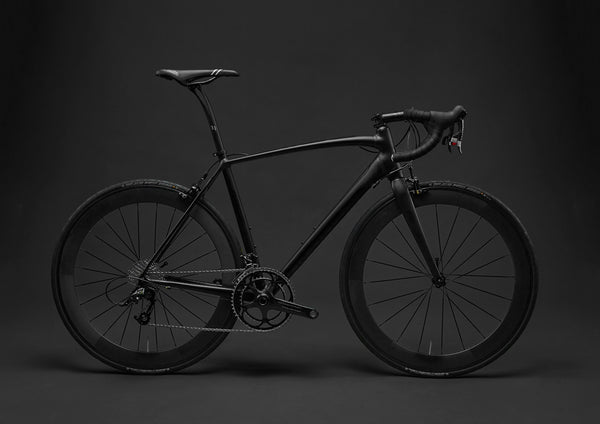Over the years, bicycle frames have been made from a variety of materials. The very first bikes from the early 1800s, which were more things to sit on with your feet still touching the ground to do the walking, were made from wood, and later 19th century pedal pushers were often made out of everything from wood to cast iron. But once the “safety bicycle”, which more closely resembles the frame shape we know today, was invented, steel tubing became the most common material used for bicycles.
Steel remained the most popular material used for all types of bicycles until the mid-1990s when more manufacturers started to experiment more and more with other materials. Aluminum became more common, and titanium also was a favorite of bespoke frame builders. Certain brands like Pinarello were keen to try other materials like their magnesium Dogma frame raced on by Fasso Bartolo in the early 2000s and other brands liked to use scandium as an alternative to aluminum thanks to its low weight and excellent stiffness properties.
But by the early 2000s, carbon fiber started to take over the high-end frame market, and it remains the most popular material for a wide range of frame types from road to gravel to mountain biking and even cargo and commuting bikes. But it can be difficult to narrow down the best bike frame material to just one option.
Best materials for bike frames
Steel
Though carbon fiber might be the elite racer’s choice, steel bike frames are still not only produced but loved by their riders. That’s because steel is a wonderful material for cycling frames. If you’ve ever had the chance to ride a well-made steel bike, then you’ll understand the truth behind the phrase “steel is real.”
Expertly drawn and butted steel tubing can be customized to the need and size of a rider so that no matter how small or tall you are, you will enjoy a responsive ride that still absorbs road chatter. Since steel tubes can be customized in length and wall thickness, a steel frame is truly fully customizable. Unlike carbon frames, most of which are only customizable in the paint job, a steel frame custom made can fit every aspect of a rider’s shape, form, and ride requirements.
Whether a classic refurb or brand new custom frame, a steel bike with its elegantly thin tubing and rim brake sleekness looks amazing. And the very fact that steel frames, whether welded or lugged, can be fixable in the case of a crash is also an excellent argument for how ecologically friendly steel frames can be. It’s not a material that is likely to wear out quickly, and if something is damaged, it almost certainly can be fixed.
Steel does have a few downsides, though, especially for the modern cyclist. It is heavier than carbon, aluminum, or titanium. This extra heft is exacerbated when someone builds a steel frame to be used with disc brakes, since the braking forces caused by disc brakes necessitate the use of more material. And if you have a classic rim brake steel bike, it can be challenging to find replacement parts since modern bike shops seldom cater to anything but the most common needs.
Nevertheless, any owner of a steel bike will confirm what a wonderful ride quality and exceptional longevity a well-made steel frame offers.
Aluminum
Though aluminum was a material used even in the early days of bicycle development, it wasn’t until the 1970s that a small number of manufactures started producing aluminum frames. The Italian manufacturer ALAN claims to have had the first production aluminum frame in the early 70s. Then the M.I.T. Aluminum Bicycles Project in 1974 set out to design super light and strong aluminum frames which sowed the seeds of what Gary Klein would first make under his eponymous bike brand. His disagreement with Cannondale resulted from both companies developing extra wide diameter alu tubing to ensure an exceptional stiffness to weight ratio.
Aluminum is less commonly used for new elite road bikes these days, but you can still find many high quality mountain bike manufacturers like Niner and Knolly including aluminum bikes in their premium line up. That’s because aluminum still offers an exceptional stiffness to weight ratio while being durable, more customizable and fixable than a carbon bike frame. And though aluminum has the reputation for offering a harsher ride than steel or carbon, our hearty recommendation would be that a high quality aluminum frame is much preferable to a medium to low quality carbon frame.
Carbon
It has been two decades now that carbon fiber has been seen as the most desirable material for high quality bicycle frame manufacturing. When well made, it can offer an exceptionally comfortable ride feel while being super responsive with a stiffness to weight ratio that far exceeds any other material.
Carbon generally is manufactured using sheets of carbon fiber that have been pre-impregnated by resin. The sheets are then cut to size and laid-up according to a specific design program so that the different parts of the frame offer the qualities that those areas require. For instance, the bottom bracket needs to be super stiff while the seat tube should offer a level of compliance to absorb road vibrations.
Certain brands like TIME and 3T use a slightly different manufacturing process which instead weaves the carbon, sock-like, to form the tubes and then uses RTM or Resin Transfer Molding, which injects resin at high pressure between rigid external and internal molds. Using wax molds that can be melted away and reused makes this process not only exceptionally efficient and tunable, but also ecologically friendly.
Carbon has its drawbacks too. It’s an expensive material that is in demand for a lot of other, bigger industries like car and aircraft manufacturing. So when there are shortages or supply chain issues, bike manufactures suffer and inevitably pass the extra expense along to the customer. Since most carbon bikes are monocoque frames, meaning the front triangle is made from one piece and the rear triangle from another, it is almost impossible to have a custom made carbon frame unless you are willing to pay for the frame molds – which to our knowledge no manufacturer even offers as an option!
There are manufacturers who use a tube-to-tube manufacturing process, where they create the carbon tubes and then bond them together, usually with more layers of carbon. Those manufacturers who do that can offer more customizable options, but they come at a price, both in terms of weight and dollars.
Conclusion – Comparing frame materials
Though just a short survey of the different types of materials frequently used to build bikes, we hope that it has given you a better idea about why these materials have been and continue to be popular. It can be difficult to say what frame material is best for a bike, but it does help to consider what your ride goals will be when deciding which material you will want for your next bike.
You may also like our article on what bike size should you choose.



































































































































































































































































